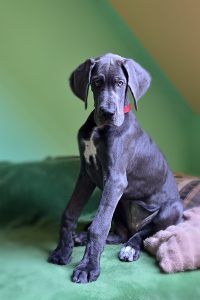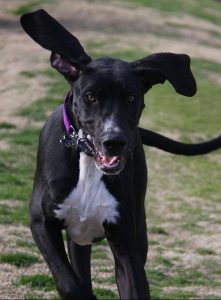A Little About Great Danes
If you ask a person where they think a Great Dane originated from, the chances are they may tell you the breed came from Denmark.
This is not true as the breed was developed in Germany in the 16th century. These dogs were originally used for hunting boar.
When the breed was first noticed the dogs were ferocious and had very aggressive natures, but as the years have progressed a calmer breed has emerged with the dogs being know now as ‘gentle giants.’
If you ask any Great Dane owner, you will find out that these dogs are very big lap dogs and love nothing more than cuddles!
They are loyal and kind, affectionate and gentle. They make excellent pets for families because they are renowned for their patience towards children.
Probably one of the reasons why more people do not have Great Danes as pets is because there is a huge amount of hair to clean up every day.
Do Great Danes Shed?
Great Danes are classed as moderate shedders and compared to other breeds they do shed a lot less.
However, simply because of the size of the dog, you will find that they seem to shed a lot. If it is important that you have a hair free home, then you may want to consider a smaller type of dog.
Great Danes shed the most during the Springtime. This is often called the ‘blowing out’ season and is the time when your gentle giant gets rid of a winter coat in order to stay cooler in the summer.
Even though Great Danes are single coat dogs, they will still leave hair all over the house.
About A Great Danes Coat Shedding
It makes no difference if your dog has a single or double layer coat because it is the follicles which have a life cycle and this dictates when and how much the dog will shed.
Coats have four stages to them, namely:
Anagen phase (the growing phase): This is when new hair is growing it’s best.
Catagen phase (the transition phase): This is when the hair has stopped growing and has reached its peak.
Telogen phase (the resting phase): This is when the hair is dormant, neither growing nor falling out.
Exogen phase (the transition phase): This is when the hair has reached the end of its cycle and falls out.
Growth rates depend of dog breeds and so do starting and end points of each cycle.
Although there are four main stages of the hair cycle, there is never a time when nothing happens. The hair never stops doing something, even when it is falling out.
Some breeds which have hair instead of fur such as Poodles will remain in the growth phase for longer, until the hair is clipped.
Depending on the climate the hair may stay in the growing phase for longer and this is to keep the dog warm through the winter months.
What is a Great Danes Coat Like?
 The coats of all dogs fall into two categories, namely single coats and double coats. Any breed that has a double coat will shed more because they drop more hair than a dog with a single coat.
The coats of all dogs fall into two categories, namely single coats and double coats. Any breed that has a double coat will shed more because they drop more hair than a dog with a single coat.
Although Great Danes fall into the category of a single coat dog, simply because they are huge creatures, they will appear to shed a lot.
The coat of the Great Dane is smooth and short, and of single layer. It is easy to groom and low maintenance. The Great Dane will shed most of the year although you can expect them to shed more in the spring.
One thing is sure about any dog, and that is that you cannot stop the shedding cycle. It is not preventable and is a normal process for dogs.
The amount they shed depends on the breed and the type of hair. It also depends on the diet.
While an excessive amount of shedding may be a sign that the dog is in ill health, it can also be due to a less than good diet or even an allergy to certain foods.
How Much do Great Danes Shed?
If your Great Dane was the size of any other single coat dog, they would shed about the same amount, maybe even a little less. The reason we see more shed hair is because the breed is so large.
The ‘blowing out‘ phase happens during the spring when they lose their winter coats. It also will typically happen when the temperatures rise and there is more daylight.
There are very few other times of the year when a Great Dane will shed. If they are shedding excessively it may be due to health reasons, so it is a good idea to have the vet check the pooch out.
When do Great Danes Shed the Most?
In the springtime you will find your house has more hair in it than in the cooler months. Great Danes do not shed as much as other single coat breeds, but you will still need to vacuum your home every day.
How to Manage Great Danes Shedding?
The best way to control and keep on top of shedding is by grooming your dog.
With the Great Dane it is necessary that you establish a brushing routine and stick to it. Regular brushing stimulates the blood flow and removes all the loose, dead hair.
Ideally, having wooden floors mean less hair than if you have a carpet in the house. Wooden floors will need brushing and wiping over to keep them looking good, while carpet will need to be vacuumed daily.
Removable covers of sofas and chairs are a good idea as they can be removed weekly and washed.

While Great Danes do not have hair that gets long enough to mat and tangle, they still need the dead hair removed.
Ideally the best place for you to brush your Great Dane is outside. This will reduce the amount of hair which will fly around inside while you groom your pooch.
Use a firm bristle brush once or twice a week in the non-shedding season, and then use if daily when shedding starts.
You should aim to spend between 10 – 15 minutes daily brushing them during the shedding season.
Baths are another way to keep shedding under control. Although you should not bath a Great Dane more than once a week. Anything more will remove the essential oils from the hair and skin and leave the skin dry and irritated.
If you feel that your Great Dane is shedding more than you expect, you may want to take a closer look at the food you are feeding your dog.
It is advisable to add Omega 3 to the diet to keep the skin and hair as healthy as possible. Fresh water at hand through the day, with no limitations will ensure that any excess bacteria and toxins are removed from the body.
Equipment Help to Manage Great Danes Shedding
One of the best brushes for a great Dane is a Furminator de-shedding brush. This is a great brush to use with dogs who have either type of coats.
If you can’t get hold of a Furminator, then a good bristle brush will work as well.
If you intend to bath your pooch, then make sure that you use doggie shampoo and conditioner. Don’t be tempted to use your own shampoo as the pH will not be correct for your dog and it may irritate the skin.
Are Great Danes Considered to be Hypoallergenic?
The answer to this question is ‘no’, Great Danes are most certainly not considered to be hypoallergenic. They are shedders because of their immense size and are classed as moderate shedders.
The truth about shedders and hypoallergenic dogs is that all dogs shed and there really is no such things as a truly hypoallergenic dog.
Even dogs who have no hair shed to some degree and a Great Dane will drop hair because there is more dog than most!
Do Some Great Danes Shed More Than Others?
All Great Danes shed the same amount because the breed does not have any variations to it. You will find that one pup sheds about the same as the next.
The only reason for one Dane to shed more is if there is something else that is bothering him, such as an allergy or illness.
Great Danes coats are classed as low maintenance and very manageable, but you will still find hair all over the house.
Reasons for Increased Shedding in Great Danes
Diet
It is essential that your Great Dane has a good diet in order to keep the skin and hair in good condition.
Once your dog is no longer a pup, he should not eat puppy food as this will not provide the important nutrients he needs. Puppy food for Great Danes differs from food for adult dogs.
Stress
Great Danes do not normally suffer from anxiety disorders, although they would prefer to not be left alone.
Stress may cause your pooch to shed more and if you feel your dog is shedding more than you expect, then you should get to the vet for a check-up.
Allergies
Allergies and skin sensitivity may cause your pooch to shed more than what is normal. The vet will be able to test and see what is causing the extra shedding.
Final Thoughts
 So, it seems that if you can cope with the shedding and extra fur in the house, the Great Dane will make a great family pet.
So, it seems that if you can cope with the shedding and extra fur in the house, the Great Dane will make a great family pet.
Loyal and affectionate, these gentle giants bring a whole lot more to the table than many other breeds.
If you can cope with the shedding, then you will find that you have a life long friend as well as a loyal companion.

